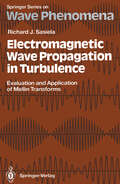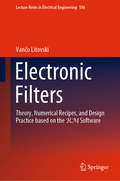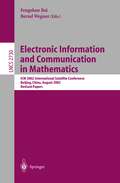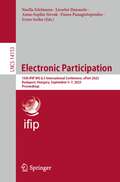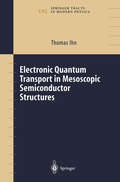- Table View
- List View
Electromagnetic Wave Propagation in Turbulence: Evaluation and Application of Mellin Transforms (Springer Series on Wave Phenomena #18)
by Richard J. SasielaElectromagnetic Wave Propagation in Turbulence is devoted to a method for obtaining analytical solutions to problems of electromagnetic wave propagation in turbulence. In a systematic way the monograph presents the Mellin transforms to evaluate analytically integrals that are not in integral tables. Ample examples of application are outlined and solutions for many problems in turbulence theory are given. The method itself relates to asymptotic results that are applicable to a broad class of problems for which many asymptotic methods had to be employed previously.
Electromagnetic Wave Scattering on Nonspherical Particles: Basic Methodology and Simulations (Springer Series in Optical Sciences #145)
by Tom Rother Michael KahnertThis book gives a detailed overview of the theory of electromagnetic wave scattering on single, homogeneous, but nonspherical particles. Beside the systematically developed Green’s function formalism of the first edition this second and enlarged edition contains additional material regarding group theoretical considerations for nonspherical particles with boundary symmetries, an iterative T-matrix scheme for approximate solutions, and two additional but basic applications. Moreover, to demonstrate the advantages of the group theoretical approach and the iterative solution technique, the restriction to axisymmetric scatterers of the first edition was abandoned.
Electromagnetics: Theory, Techniques, and Engineering Paradigms
by Giorgio FranceschettiDuring the last twenty years the lifestyle of a large portion of the inhabitants of our planet has changed dramatically. This would never have been possible without the massive use of electronic and photonic technology, telecommuni cations, and computers. These disciplines are designed to code, transmit, detect, decode, and process signals and related information, and can be broadly addressed as information science and technology. In the sophisticated society in which we live and operate, this science is diffused transversely and plays a major role in almost every human activity. Information science and technology is the basis of a powerful industry that does not suffer the shortcomings of more traditional human enterprises. Information is a renewable source and its control and processing rely on software codes, which are a creation of the mind, and on related hardware, incredibly sophisticated but made out of simple, abundant materials. The rate of change and transformation of this industry is the highest mankind has ever experienced, and it requires not only the replacement of technologies but also a continuous updating of expertise to keep up with the rapid transformation. There is no doubt that this calls for a change in university training, to avoid students graduating at an already obsolete level.
Electromagnetics, Control and Robotics: A Problems & Solutions Approach
by Harish ParthasarathyThis book covers a variety of problems, and offers solutions to some, in:• Statistical state and parameter estimation in nonlinear stochastic dynamical system in both the classical and quantum scenarios.• Propagation of electromagnetic waves in a plasma as described by the Boltzmann Kinetic Transport Equation.• Classical and Quantum General Relativity. It will be of use to Engineering undergraduate students interested in analysing the motion of robots subject to random perturbation, and also to research scientists working in Quantum Filtering.
Electromagnetics, Control and Robotics: A Problems & Solutions Approach
by Harish ParthasarathyThis book covers a variety of problems, and offers solutions to some, in:• Statistical state and parameter estimation in nonlinear stochastic dynamical system in both the classical and quantum scenarios.• Propagation of electromagnetic waves in a plasma as described by the Boltzmann Kinetic Transport Equation.• Classical and Quantum General Relativity. It will be of use to Engineering undergraduate students interested in analysing the motion of robots subject to random perturbation, and also to research scientists working in Quantum Filtering.
Electromagnetism: With Solved Problems (Undergraduate Texts in Physics)
by Hiqmet KamberajAny curriculum involving science and/or engineering will eventually find itself entering the realm of physics. This book seeks to introduce students to a number of the fundamental concepts in physics and illustrate how different theories were developed out of physical observations and phenomena. The book presents multi-chapter sections on electrostatics, magnetism and electromagnetic waves, with eyes on both the past and the future, touching, along the way, on Coulomb, Gauss, Maxwell, Ohm, Biot-Savart, Ampere, Faraday, Fresnel and Lorentz. The book also contains an appendix that provides the reader with a portion of the mathematical background of vector analysis and vector differential operators. The book approaches its topics through a focus on examples and problem-solving techniques, illustrating vividly how physical theories are applied to problems in engineering and science. The book is primarily aimed at undergraduate students in these two fields, but it also features chapters that are geared towards senior undergraduates working on their final year theses.
Electron-Beam Interactions with Solids: Application of the Monte Carlo Method to Electron Scattering Problems (Springer Tracts in Modern Physics #186)
by Maurizio DaporThe interaction of an electron beam with a solid target has been studied since the early part of the past century. Since 1960, the electron–solid interaction hasbecomethesubjectofanumberofinvestigators’workowingtoitsfun- mental role in scanning electron microscopy, in electron-probe microanalysis, in Auger electron spectroscopy, in electron-beam lithography and in radiation damage. The interaction of an electron beam with a solid target has often been investigated theoretically by using the Monte Carlo method, a nume- cal procedure involving random numbers that is able to solve mathematical problems. This method is very useful for the study of electron penetration in matter. The probabilistic laws of the interaction of an individual electron with the atoms constituting the target are well known. Consequently, it is possible to compute the macroscopic characteristics of interaction processes by simulating a large number of real trajectories, and then averaging them. The aim of this book is to study the probabilistic laws of the interaction of individual electrons with atoms (elastic and inelastic cross-sections); to - vestigate selected aspects of electron interaction with matter (backscattering coe?cients for bulk targets, absorption, backscattering and transmission for both supported and unsupported thin ?lms, implantation pro?les, seconda- electron emission, and so on); and to introduce the Monte Carlo method and its applications to compute the macroscopic characteristics of the inter- tion processes mentioned above. The book compares theory, computational simulations and experimental data in order to o?er a more global vision.
Electron Correlations and Materials Properties
by A. Gonis Nicholis Kioussis Mikael CiftanThis volume, the proceedings of a 1998 international workshop, provides experimental evidence of the effects of correlation on the physical, chemical, and mechanical properties of materials, as well as the theoretical/computational methodology that has been developed for their study.
Electron Correlations in Molecules and Solids (Springer Series in Solid-State Sciences #100)
by Peter FuldeThis volume bridges the gap between quantum chemistry and solid-state theory. The text develops new concepts for treating many-body and correlation effects, and deals with applications of the theory to molecules, semiconductors, transition metals, heavy-fermion systems, and the new high-Tc superconducting materials.
Electron Correlations in Molecules and Solids (Springer Series in Solid-State Sciences #100)
by Peter FuldeDieser Titel verbindet die Festkörpertheorie mit der Quantenchemie. Neue Konzepte der Vielteilchen-Verarbeitung und Korrelations-Effekte, normale quantenchemische Verfahren mit Projektionstechniken, Greensche Funktionen und Monte-Carlo-Methoden werden erarbeitet. Anwendungsbereiche der Molekültheorie, von Halbleitern, supraleitender high-Tc-Materialien, etc., werden vorgestellt.
Electron Energy Loss Spectrometers: The Technology of High Performance (Springer Series in Optical Sciences #63)
by Harald IbachElectron energy loss spectroscopy has become an indispensable tool in surface analysis. Although the basic physics of this technique is well understood, instrument design has previously largely been left to intuition. This book is the first to provide a comprehensive treatment of the electron optics involved in the production of intense monochromatic beams and the detection of scattered electrons. It includes a full three-dimensional analysis of the electron optical properties of electron emission systems, monochromators and lens systems, placing particular emphasis on the procedures for matching the various components. The description is kept mathematically simple and focuses on practical aspects, with many hints for writing computer codes to calculate and optimize electrostatic lens elements.
Electron Localization-Delocalization Matrices (Lecture Notes in Chemistry #112)
by Chérif F. Matta Ronald Cook Paul W. AyersThis book builds bridges between two yet separated branches of theoretical and mathematical chemistry: Chemical Graph Theory and Electronic Structure Calculations. Although either of the fields have developed their own techniques, problems, methods, and favorite benchmark cases independent from each other, the authors have managed to bring them together by using the localization-delocalization matrix (LDM). The LDM is a novel molecular descriptor that fingerprints a molecule by condensing the complicated electronic information in one, mathematically manageable, object. In this book, the authors introduce the readers to modeling techniques based on LDMs. Their technique offers a high accuracy as well as robust predictive power, often dramatically surpassing the potential of either of the constituting methods on their own. In addition to the comprehensive and accessible introduction to this new field of theoretical chemistry, the authors offer their self-developed software free to download, so that readers can try running their own simulations. The described methods are very general and can easily be implemented for calculating various properties and parameters such as mosquito repelling activity, ionic liquid properties, local aromaticity of ring molecules, log P's, pKa's, LD50, corrosion inhibition activities, and Lewis acidities and basicities – to only name a few. The free downloadable software helps readers automate the analysis of the matrices described in this book and hence facilitates application of the described methodology.
The Electron Mass and Calcium Isotope Shifts: High-Precision Measurements of Bound-Electron g-Factors of Highly Charged Ions (Springer Theses)
by Florian Köhler-LangesThis thesis presents the first isotope-shift measurement of bound-electron g-factors of highly charged ions and determines the most precise value of the electron mass in atomic mass units, which exceeds the value in the literature by a factor of 13. As the lightest fundamental massive particle, the electron is one of nature’s few central building blocks. A precise knowledge of its intrinsic properties, such as its mass, is mandatory for the most accurate tests in physics - the Quantum Electrodynamics tests that describe one of the four established fundamental interactions in the universe. The underlying measurement principle combines a high-precision measurement of the Larmor-to-cyclotron frequency ratio on a single hydrogen-like carbon ion studied in a Penning trap with very accurate calculations of the so-called bound-electron g-factor. For the isotope-shift measurement, the bound-electron g-factors of two lithium-like calcium isotopes have been measured with relative uncertainties of a few 10^{-10}, constituting an as yet unrivaled level of precision for lithium-like ions.
Electron-Photon Interaction in Dense Media (NATO Science Series II: Mathematics, Physics and Chemistry #49)
by Helmut WiedemannA comprehensive survey of recent theoretical and experimental progress in the area of electron-photon interaction and dense media. A state-of-the-art discussion of radiation production, with descriptions of new ideas and technologies that enhance the production of X-rays in the form of channelling, transition and parametric X-ray production. Progress in electron beam physics to produce sub-picosecond electron bunches from low-energy linear accelerators make it possible to produce coherent, high brightness, submillimeter radiation and sub-picosecond X-ray pulses. Micro-undulators in the form of bent crystalline structures hold great promise as future X-ray sources.
Electronic Business Revolution: Opportunities and Challenges in the 21st Century
by Peter Cunningham Friedrich FröschlElectronic business, the integration of IT and the Internet into business processes, has begun to completely revolutionize business and the economy. The aim of this book is to point out the challenges and opportunities Europe and its companies are faced with in electronic business. The material is based upon the authors joint experience of years of research into the use of IT in business, industry, and government, as well as their management experience as President and CEO of leading technology organizations.
Electronic Density Functional Theory: Recent Progress and New Directions
by John F. Dobson Giovanni Vignale Mukunda P. DasThis book is an outcome of the International Workshop on Electronic Density Functional Theory, held at Griffith University in Brisbane, Australia, in July 1996. Density functional theory, standing as it does at the boundary between the disciplines of physics, chemistry, and materials science, is a great mixer. Invited experts from North America, Europe, and Australia mingled with students from several disciplines, rapidly taking up the informal style for which Australia is famous. A list of participants is given at the end of the book. Density functional theory (DFT) is a subtle approach to the very difficult problem of predicting the behavior of many interacting particles. A major application is the study of many-electron systems. This was the workshop theme, embracing inter alia computational chemistry and condensed matter physics. DFT circumvents the more conceptually straightforward (but more computationally intensive) approach in which one solves the many-body Schrodinger equation. It relies instead on rather delicate considerations involving the electron number density. For many years the pioneering work of Kohn and Sham (the Local Density Ap proximation of 1965 and immediate extensions) represented the state of the art in DFT. This approach was widely used for its appealing simplicity and computability, but gave rather modest accuracy. In the last few years there has been a renaissance of interest, quite largely due to the remarkable success of the new generation of gradient functionals whose initiators include invitees to the workshop (Perdew, Parr, Yang).
Electronic Filters: Theory, Numerical Recipes, and Design Practice based on the RM Software (Lecture Notes in Electrical Engineering #596)
by Vančo LitovskiThis book provides a comprehensive overview of signal filtering, including an introduction, definitions of the terms and algorithms for numerical calculation of the properties of the transfer function in frequency and time domains. All the chapters discuss the theoretical background and explain the underlying algorithms including the iterative numerical procedures necessary to obtain the solutions. It starts by considering polynomial filters, offering a broad range of solutions and introducing critical monotonic passband amplitude characteristics (CMAC). It also describes modifications to the classical Chebyshev and elliptic filters to overcome their limitations. In the context linear phase low-pass prototypes, it presents filters approximating constant group delay in the equi-ripple manner for the first time. Further, it discusses new procedures to improve the selectivity of all polynomial filters by introducing transmission zeros, such as filters with multiple transmission zeros on the omega axis, as well as phase correction of selective filters for both low-pass and band-pass filters. Other topics explored include linear phase all-pass (exhibiting low-pass group delay approximation) filters; all-pass filters (exhibiting band-pass group delay approximation) with linear and parabolic phase synthesized directly as band-pass; high-pass, and band-stop amplitude characteristic frequency transformations to produce band-pass; and direct synthesis of linear and parabolic phase selective band-pass filters synthesized directly as band-pass. Lastly, for system (physical) synthesis, the book describes the algorithms and procedures for the following: cascade passive LC; active cascade RC; active parallel RC (for the first time); active parallel SC; Gm-C based on LC prototypes; and parallel IIR based on bilinear transformation of analog prototypes. Every algorithm, be it in transfer function synthesis or in system synthesis, is accompanied by a proper nontrivial comprehensive example produced by the RM software.
Electronic Government and the Information Systems Perspective: 11th International Conference, EGOVIS 2022, Vienna, Austria, August 22–24, 2022, Proceedings (Lecture Notes in Computer Science #13429)
by Andrea Kő Enrico Francesconi Gabriele Kotsis A Min Tjoa Ismail KhalilThis volume LNCS 12429 constitutes the papers of the 11th International Conference on Electronic Government and the Information Systems Perspective, EGOVIS 20221, held in Vienna, Austria, in August 2022. The 11 full papers presented were carefully reviewed and selected from 16 submissions and focus on information systems and ICT aspects of e-government. The papers are organized in 3 topical sections: e-government theoretical background; semantic technologies and legal issues;; artificial intelligence and machine learning in e-government context.
Electronic Government and the Information Systems Perspective: 13th International Conference, EGOVIS 2024, Naples, Italy, August 26–28, 2024, Proceedings (Lecture Notes in Computer Science #14913)
by Ismail Khalil A Min Tjoa Gabriele Kotsis Andrea KöThis book constitutes the proceedings of the 13th International Conference on Electronic Government and the Information Systems Perspective, EGOVIS 2024, which took place in Naples, Italy, in August 2024. The 10 full and 5 short papers included in this book were carefully reviewed and selected from 24 submissions. They were organized in topical sections as follows: AI in E-Government; E-Government cases; mobile government and digital inclusion; open government data and security.
Electronic Government and the Information Systems Perspective: 12th International Conference, EGOVIS 2023, Penang, Malaysia, August 28–30, 2023, Proceedings (Lecture Notes in Computer Science #14149)
by Andrea Kö Enrico Francesconi Adeleh Asemi Gabriele Kotsis A Min Tjoa Ismail KhalilThis book constitutes the proceedings of the 12th International Conference on Electronic Government and the Information Systems Perspective, EGOVIS 2023, which took place in Penang, Malaysia, during August 28-30, 2023.The 8 full papers presented together with 1 short paper were carefully reviewed and selected from a total of 17 submissions. They were organized in topical sections as follows: e-Government; strategy; artificial intelligence.
Electronic Information and Communication in Mathematics: ICM 2002 International Satellite Conference, Beijing, China, August 29-31, 2002, Revised Papers (Lecture Notes in Computer Science #2730)
by Fengshan Bai Bernd WegnerElectronic, Magnetic, and Thermoelectric Properties of Spinel Ferrite Systems: A Monte Carlo Study, Mean-Field Theory, High-Temperature Series Expansions, and Ab-Initio Calculations (SpringerBriefs in Materials)
by Rachid MasrourThis book explores magnetic properties and critical temperatures in inverse ferrite Fe₃⁺(M₂⁺Fe₃⁺)O₄ spinels (e.g., Fe, Co, Ni). It calculates transition and Curie Weiss temperatures, providing insights into their thermodynamic behavior. Using the full potential linearized augmented plane wave (FP-LAPW) method, it investigates electrical and magnetic structures of spinel chromite, revealing magnetic moments in MnCr₂S₄. Seebeck coefficient and electrical conductivity are also calculated. Advanced techniques like Monte Carlo, DFT+U, and FLAPW analyze magnetic characteristics of LiMn₁.₅Ni₀.₅O₄ and electronic/magnetic structures of Fe₃O₄. High-temperature series expansions calculate Néel temperature and critical exponents, while GFT determines thermal magnetization and susceptibility. The analysis exposes exchange interactions' effects on magnetic order and introduces asymmetric phases in ferrimagnetic spinel systems. This book serves as an invaluable resource for researchers, academics, and enthusiasts seeking a comprehensive understanding of magnetic properties and critical phenomena within diverse spinel materials.
Electronic Participation: 15th IFIP WG 8.5 International Conference, ePart 2023, Budapest, Hungary, September 5–7, 2023, Proceedings (Lecture Notes in Computer Science #14153)
by Noella Edelmann Lieselot Danneels Anna-Sophie Novak Panos Panagiotopoulos Iryna SushaThis book constitutes the proceedings of the 15th IFIP WG 8.5 International Conference on Electronic Participation, ePart 2023, held in Budapest, Hungary, in September 2023, in conjunction with the IFIP WG 8.5 Conference on Electronic Government (EGOV 2023) and the Conference for E-Democracy and Open Government Conference (CeDEM 2023). A total of 38 full papers has been carefully reviewed and selected from 106 submissions. Eight of the accepted papers are included in this book. They were organized in topical sections as follows: E-participation; digital transformation; digital technology; and digital sovereignty.
Electronic Participation: 16th IFIP WG 8.5 International Conference, ePart 2024, Ghent, Belgium, September 3–5, 2024, Proceedings (Lecture Notes in Computer Science #14891)
by Sara Hofmann Efthimios Tambouris Peter Parycek Thomas Lampoltshammer Csaba Csáki Gerhard Schwabe Marius Rohde Johannessen Jolien Ubacht Lieselot DanneelsThis book constitutes the refereed proceedings of the 16th IFIP WG 8.5 International Conference on Electronic Participation, ePart 2024, held in Ghent, Belgium, during September 3–5, 2024. The 15 full papers included in this book were carefully reviewed and selected from 35 submissions. The conference is dedicated to digital or electronic government, open government, local government (smart cities), smart governance, artificial intelligence (AI), e-democracy, policy informatics, and electronic participation.
Electronic Quantum Transport in Mesoscopic Semiconductor Structures (Springer Tracts in Modern Physics #192)
by Thomas IhnOpening with a brief historical account of electron transport from Ohm's law through transport in semiconductor nanostructures, this book discusses topics related to electronic quantum transport. The book is written for graduate students and researchers in the field of mesoscopic semiconductors or in semiconductor nanostructures. Highlights include review of the cryogenic scanning probe techniques applied to semiconductor nanostructures.
